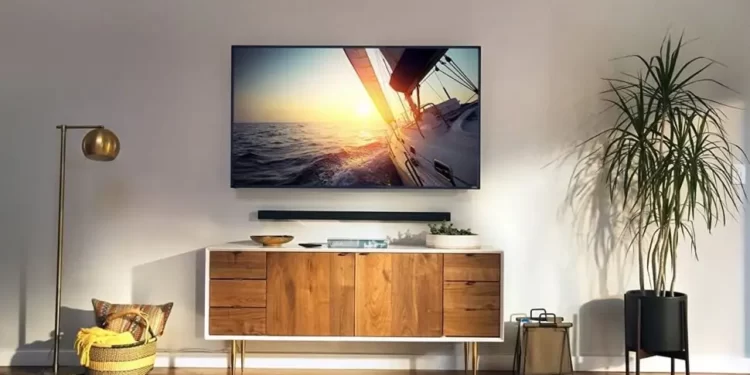TV mounting is now a common practice that people do not only to save space but also because it looks aesthetic and classy. However, it is not as simple as it looks. If you’re considering of trying, these are the basics of TV mounting that you should know.
TV mounting is the process of securely attaching a television set to a wall or other surface. This method has become more and more famous in recent years due to its aesthetic appeal, as well as its practicality. Not only does it free up floor space, but it also makes it easier for people to change the viewing angle of their TV and improve visibility. TV mounting also eliminates the need for bulky TV stands that can become an eyesore in people’s living rooms.
TV mounting is not a particularly difficult process. In fact, a lot people nowadays already do the installation themselves. However, professional TV installation services offer far more advantages. Professional TV mount installers have the right tools and knowledge to make sure that the TV is securely attached to the wall and that it is level. In addition, they can also provide helpful advice on TV configurations, such as what type of mount will work best for a specific TV size or TV model.
How to Have a Superb TV Mounting Experience
When it comes to TV mounting, there are quite a number of different mount types available. Each TV mount has its own advantages and disadvantages and selecting the right one is important for ensuring that your TV is safely secured on the wall.

- The most basic type of TV mount is a fixed mount. As its name implies, this type of TV mount is fixed in place and doesn’t allow for any movement. This type of TV mount can be used with smaller TVs, and it’s perfect if you want to keep your TV in a specific spot without the ability to move it around.
- Tilting TV mounts are another popular option. These enable the TV to be titled up or down depending on the TV’s viewing angle that fits your needs. This type of TV mount is great for positioning a TV in a corner or other awkward location.
- Full motion TV mounts are the most versatile type of TV mount available. These mounts allow you to swivel and tilt the TV, giving you a wide range of motion to adjust the TV’s view. This type of TV mount is perfect if you want to be able to move the TV around as needed.
- Finally, ceiling TV mounts are a great option for mounting your TV in places where space is at a premium. These mounts hang from the ceiling and allow you to adjust the height of your TV as needed.
At the same time, there are several things to consider when selecting a TV mount, such as TV size and weight, VESA compatibility, wall type, extension options, and ease of installation. Here are some tips for a guided purchase decision:
Step 1: Measure the TV’s size and weight. TV mounts are rated for a specific TV size and weight, so this is an important step when selecting the right mount for your TV. Measure the diagonal width of your TV in inches and make sure it meets or falls within the recommended TV size range of the mount that you’re considering. TV mounts also have a specific TV weight rating, so check to make sure the TV weight is within the recommended range.
Step 2: Check for VESA compatibility. VESA stands for Video Electronics Standards Association and it’s an industry standard that specifies TV mounting hole patterns on TVs and TV mounts. Make sure the TV mount you’re considering is compatible with your TV’s VESA pattern.
Step 3: Consider the type of wall on which you’ll be mounting the TV. The most common wall types for TV mounting are drywall, brick, or concrete. Choose a TV mount specifically designed to work with the type of wall you’ll be using.
Step 4: Look at TV mount extension options. TV mounts come in a range of sizes and many have adjustable arms that allow you to extend the TV further away from the wall. If you plan on moving your TV around or adjusting its position frequently, then an adjustable arm TV mount may be the best option for you.
Step 5: Consider the TV mount’s ease of installation. TV mounts come with different levels of complexity when it comes to installation, so make sure you read up on the mount’s instructions and look at customer reviews before deciding which one is right for you. TV mounting can be a DIY project but if you need help, there are TV mounting services available in many areas.
TV Mounting – Is it safe?
TV mounting is a great way to save space and enhance the visual appeal of your home also this Conn’s HomePlus. However, it also comes with certain risks that could damage your TV if not properly taken into account. For your TV to remain undamaged, take a look at these helpful tips below:
- Make sure the TV mount is secure. A TV falling from a wall or ceiling can cause serious damage, and improper installation of the TV mount can be to blame. Make sure that the TV is mounted using proper hardware and techniques, such as securing it with anchors in the wall or ceiling.
- Use surge protectors. To protect your TV from power surges, make sure to plug it into a surge protector. This will help protect the TV from electrical interference and ensure that your TV is safe when powered on.
- Keep away from heat sources. TV’s can overheat easily, so it’s important to keep them away from direct sunlight or other heat sources. To avoid this, make sure to mount your TV in a cool and well-ventilated area.
- Clean regularly. Dust is one of the main sources of TV damage and can quickly accumulate on a mounted TV. To keep it looking good and working properly, make sure to wipe down your TV with a soft cloth every few weeks to remove any dust or grime.
By following these tips and taking extra precautions, you can ensure your TV is safe and in good condition when mounted. TV mounting is a great way to save space and enhance the visual appeal of your home, but it’s important to take the proper steps to protect your TV from any potential hazards.






